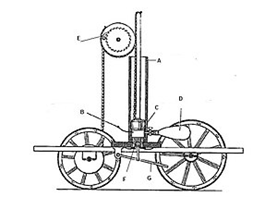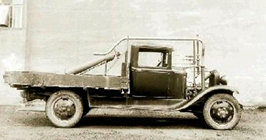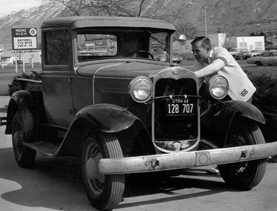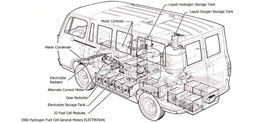HISTORY
This chapter briefly tells the history of hydrogen, from the 18th century up to this day. You will learn about some early inventions of hydrogen combustion engines and ideas that are still relevant in hydrogen development today.
We know that way back in 1700 there were attempts to invent self-moving carriages, without using a horse as a transportation method. The Frenchman Cugnot constructed a carriage powered by a steam engine, and its purpose was to carry a cannon for the army. This self moving carriage was given the name automobile from the Greek word autos which means self and the Latin word mobilis which means moving. Unfortunately it all ended very abruptly. Cugnot's carriage ran into a wall and was totally destroyed.
When reading history about engines, you notice that Nicolaus Otto was the inventor of, supposedly, the first engine with an internal combustion chamber. The Diesel engine was invented by Rudolf Diesel; he also named the fuel. All this took place sometime in the middle 1800’s, unfortunately it's hard to be precise due to when the invention was patented. Otto was first with the modern internal combustion chamber engine in 1876, but even before that, Etienne Lenoir successfully invented an internal combustion chamber engine for commercial use circa 1860. With all this in mind, a gentleman called Francois Isaac de Rivaz was even before Étienne, Rudolf and Otto.[1] He was born in France in 1752 and later moved to Switzerland where he became an inventor and politician. Early in the 1800’s, Francois had a primitive engine ready.

A little later he also had a horseless carriage; where he put in another one of his engines, this was claimed to be the World's first internal combustion chamber engine to power an automobile. And circa 1809, he traveled around the lake Geneva.

But Francois was probably too early for his time, as few believed in him, and claimed that his invention would never be able to compete with the steam engines. But what Francois used for fuel was not diesel or gasoline, he used hydrogen.
We move half a century forward, 1860, and another inventor, a Frenchman by the name Etienne Lenoir, developed the three wheeler Hippomobile. Lenoir's Hippomobile was powered by a one cylinder two- stroke engine. The hydrogen was produced by electrolyzing water, and the gas was fed to the engine.
The next hydrogen car in line was invented in Norway in 1933, when Norway's Norsk Hydro power company converted a small truck. The truck was equipped with an ammonia reformer that produced hydrogen which was then fed to the internal combustion chamber engine.

In 1941 when the World was at war, the German Nazi army had surrounded Leningrad, which led to slowly running out of gasoline for the military vehicles. The lack of gasoline compelled "new" inventions. Therefore Russia's Boris Shelishch, converted 200 GAZ-AA trucks to run on hydrogen, it showed that they burned cleaner and ran longer than those which had run on gasoline. For some reason all the detailed documents regarding hydrogen as a fuel alternative have mysteriously gone missing after World War Two, and they are still missing.
1959 Harry Karl Ihrig modified an Allis-Chalmers farm tractor to create the first fuel cell vehicle in history. Fuel cells are not going to be described here, just pointing out that there was a continuously parallel development in both these paths for alternatives for fossil fuel this early in history. [1]

1966 was a successful year for hydrogen both when it comes to internal combustion chamber engines and hydrogen for fuel cell vehicles. Roger Billings gave new light to the hydrogen fuel and converted a regular Ford model-A truck to run on hydrogen fuel in its normal gasoline engine.[1]

The same year General Motors created the GM Electrovan fuel cell vehicle, which is recognized by many to be the first fuel cell vehicle passenger automobile of record.

Since then the development for both running hydrogen in internal combustion chamber engines and fuel cell vehicles have advanced forward.
[1]Roger Billings (Billings, 2013)
[1](National Museum of American History, n.d.)
[1](Wikipedia, 2019)